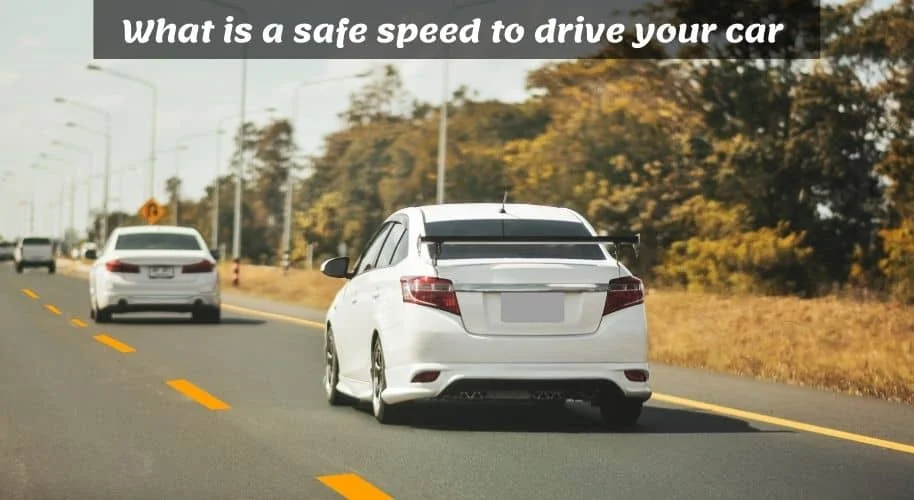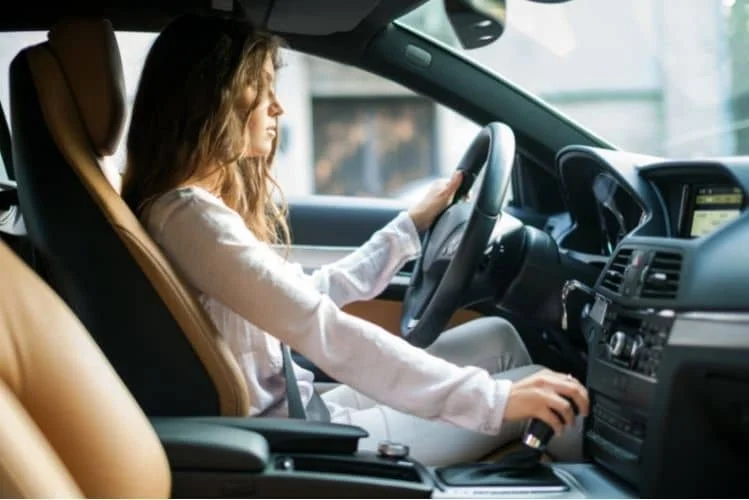Last Updated on March 14, 2023 by Henry T. Hawkins
How fast is too fast when you’re driving your car? What’s the safe speed limit for the road you’re on? These are questions that many drivers ask themselves, and it can be tough to determine what the right answer is. In this blog post, we will explore what is the safe speed to drive your car, and we’ll also provide some tips on how to stay safe while driving so that you can avoid accidents.

- What is the safe speed to drive your car?
- What are the factors that influence the speed limit of a car?
- Highways with little traffic:
- Highways with heavier traffic:
- School zones:
- Wet or icy roads:
- Poor visibility:
- Construction zones:
- Sharp turns or blind spots:
- Road with more pedestrians:
- Turn onto a road from a side street or driveway:
- Railroad crossings and busy intersections:
- Highway with a speed limit of 55 mph:
- Highway with two-lane and a lot of traffic:
- Tips To Avoid Speeding
- Why is it essential to drive the speed limit?
- Wrapping Up
What is the safe speed to drive your car?
The safest speed to drive your car is no more than 55 mph (88 km/h) if there is no limit is posted. However, you should keep the actual speed below the posted limit under most circumstances.
For example: If the posted limit on a slippery road or in poor weather conditions is 60 mph (97 km/h), or 65 mph (105 km/h), you should drive no more than 55 mph (88 km/h).
If you’re driving in a school zone, the speed limit is usually lower than it is in other areas. This is because there are generally more pedestrians present, and they may not be able to see your car coming if you’re driving too fast.
Whenever possible, you should try to avoid driving in areas where there are a lot of pedestrians. If you must drive in these areas, be sure to go slow and be extra cautious.
Also read: Is there an advantage to buying tires at Costco
What are the factors that influence the speed limit of a car?

There are many factors that influence the speed limit of a car, including the type of road, weather conditions, and the number of vehicles and pedestrians present on the road. In general, the posted speed limit is the maximum speed that you should be driving under ideal conditions. However, if the conditions are not perfect (for example, if it’s raining or snowing), you should slow down to a safe speed.
Here, we have listed a few factors that you should consider when determining the safe speed to drive your car:
Highways with little traffic:
The posted speed limit is usually the maximum speed that you should be driving under ideal conditions. Normally, you can drive above 55 mph (88 km/h) on highways with little traffic without much concern.
Highways with heavier traffic:
If the highway is more crowded, safe driving speeds will be limited to around 65 mph (105 km/h). This is because there will be more vehicles on the road, and it will be more difficult to see what’s ahead of you.
School zones:
The speed limit in school zones is usually lower than it is in other areas. You should drive at least 10 mph slower than the recommended speed limit when approaching a school zone.
Wet or icy roads:
Wet or icy roads can be very dangerous, and you should drive at a safe speed when conditions are not ideal. On wet roads and in icy conditions, you should reduce your speed by 10 mph (16 km/h) or more.
Poor visibility:
If you can’t see well ahead of you, such as hills or curves, you should slow down your speed by 10 mph (16 km/h). This is also important at night when it can be more difficult to see what’s ahead of you.
Construction zones:
Construction zones are another area where you should slow down your speed by at least 15 mph (24 km/h). This is because there may be workers present, and the road may not be in the best condition.
Sharp turns or blind spots:
Be extra cautious when driving around sharp turns or blind spots. You should slow down your speed by 10 mph (16 km/h) to have more time to react if someone suddenly appears.
Road with more pedestrians:
If you’re driving in an area with more pedestrians, you should reduce your speed by 5 mph and be extra cautious. You don’t want to hit someone, and you also want to give yourself enough time to stop if someone walks out in front of you.
Turn onto a road from a side street or driveway:
You should always yield to oncoming traffic when you’re turning onto a road from a side street or driveway. You should also slow down your speed by 5 mph.
Railroad crossings and busy intersections:
Railroad crossings and busy intersections can be dangerous, so you should always slow down your speed by at least 5 mph. This will give you more time to react if something happens.
Highway with a speed limit of 55 mph:
The posted speed limit is the maximum speed you should be driving under ideal conditions. However, you should slow down your speed by 5 mph.
Highway with two-lane and a lot of traffic:
If you’re driving on a highway with two-lane and a lot of traffic, you should go in the right-hand lane. You should also reduce your speed by at least 5 mph.
Also read: What brand of tires should you avoid
Tips To Avoid Speeding
1. Speed awareness courses may help drivers develop the skills to handle their speeding.
2. Those who have been accused of driving too fast may be eligible for the PCE.
3. It’s best to drive slowly, not overtake, take turns safely, and give complete attention to the traffic situation to avoid speeding.
4. Drivers should be familiar with the roads they’re driving on and the posted speed limits.
5. Always drive within the posted speed limit and never exceed the speed limit.
6. Don’t be sidetracked by radio, GPS, or conversation.
7. Keep an eye on the distance between your car and the vehicles ahead of you. Maintain a safe distance from the cars in front of you.
8. Reduce your speed in advance when approaching turns or exit ramps, or other areas where visibility is limited.
9. Keep your attention on the road at all times and, if you must look away from it for a short time, do so only occasionally.
10. Keep an eye out for any possible hazards, such as pedestrians, cyclists, or animals in the street.
11. Drink a lot of water to stay hydrated when driving.
12. Take breaks often, especially on long trips. Don’t drive if you’re tired.
13. If you’re driving in unfamiliar territory, take time to familiarize yourself with the area before going.
14. Make sure your car is in good condition and that all the lights are working.
15. Check the weather forecast before setting out on a trip.
16. Slow down when driving in bad weather, such as heavy rain or snow.
17. Never use your cell phone while driving, even hands-free devices.
18. Don’t drive if you’re under the influence of alcohol or drugs.
19. Don’t drive if you’re angry, upset, or distracted.
20. Always wear your seat belt.
21. Don’t drive if you’re not feeling well.
22. If you have a passenger, make sure they wear their seat belts.
23. Ensure everyone in the car is properly restrained in appropriate child safety seats, including infants and small children.
24. Never leave children or pets alone in a car, even for a short time.
25. Avoid driving at night if possible.
26. If you must drive at night, make sure your car’s headlights are in good condition and that you can see the road well.
27. Drive slowly and carefully on winding roads.
28. Be extra cautious when driving on icy or slippery roads.
29. Allow for more time to brake on wet roads.
30. Watch out for potholes, debris, and other obstacles on the road.
31. Don’t tailgate.
32. Use your horn sparingly.
33. Always yield to emergency vehicles.
34. Follow the rules of the road and obey traffic signals.
35. Don’t make sudden lane changes.
36. Use your turn signals when changing lanes or making turns.
37. Try to avoid driving in heavy traffic.
38. If you must drive in heavy traffic, allow for more time and be extra cautious.
39. Plan your route before setting out on a trip.
As you can see, there are many factors that you should consider when determining the safe speed to drive your car. In general, you should drive at a safe speed for the conditions. This means that you should slow down if the conditions are not ideal. Remember always to be cautious and yield to oncoming traffic when necessary. Safe driving!
Also read: What is the average tire life expectancy
Why is it essential to drive the speed limit?
There are a few reasons why driving the speed limit is important. Here are a few of the most important ones:
It’s the law:
In most places, driving over the posted speed limit is against the law. If you’re caught speeding, you could be fined or even arrested.
Safety:
Driving at a safe speed is one of the best ways to avoid accidents. When you’re driving too fast, it’s more difficult to stop your car if someone suddenly walks out in front of you or if a tire blows out.
Save money:
Driving at the speed limit can actually help you save money. If you’re driving too fast, you’re more likely to burn through fuel, and you may also end up with a speeding ticket.
Be a good example:
If you have kids, they’re likely to imitate your habits behind the wheel. By driving at the speed limit, you can set a good example for your children and teach them to be safe drivers.
As you can see, there are many good reasons to drive at the speed limit. So next time you’re behind the wheel, be sure to drive the speed limit.
Also read: Why does my new car smell like burning plastic
Wrapping Up
Thanks for reading the complete guide on a safe speed to drive your car. We hope you’ve found this guide helpful and informative. To sum up, we just want to mention that the best way to stay safe on the road is to drive at a speed that is comfortable for you and appropriate for the conditions. Remember, safety comes first!
Please share this guide with your friends and family to help spread the word about safe driving. And if you have any questions, feel free to leave us a comment below.
